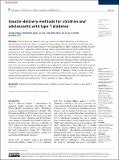| dc.description.abstract | Efforts directed toward restoring normal metabolic levels by mimicking the
physiological insulin secretion, thereby ensuring safety, efficacy, minimal invasiveness and
conveniences, are of great significance in the management of type 1 diabetes among children
and adolescents. Regardless of the various technologies being discovered in addressing
invasiveness and enhancing medication adherence in the management of type 1 diabetes,
yet limited success had been observed among children and adolescents. The multiple daily
subcutaneous insulin injections route using vial and syringe, and occasionally insulin pens,
remain the most predictable route for insulin administration among children and adolescents.
However, this route has been associated with compromised patient compliance, fear of
injections and unacceptability, resulting in poor glycemic control, which promote the demand
for alternative routes of insulin administration. Alternative routes for delivering insulin are
being investigated in children and adolescents with type 1 diabetes; these include the hybrid
closed-loop ‘artificial pancreas’ system, oral, inhalation, intranasal routes, and others. This
review article explores the current advances in insulin-delivery methods that address the
needs of children and adolescents in the treatment of type 1 diabetes. | en_US |

